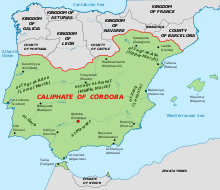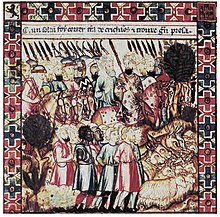| Part of a series on |
| Forced labour and slavery |
|---|
 |




Slavery was a practice throughout Al-Andalus and the Iberian Peninsula (present-day Spain and Portugal) between the 8th-century and the 15th century. This includes the periods of the Emirate of Córdoba (756–929), the Caliphate of Córdoba (929–1031), the Taifas (11th century), Almoravid rule (1085–1145), Almohad rule (1147–1238), and the Emirate of Granada (1232–1492).
Slavery in al-Andalus was regulated in accordance with Islamic law. Non-Muslims foreigners were viewed as legitimate targets of enslavement. Since al-Andalus was a situated in the religious border zone, it had the conditions necessary to become a center of slave trade between Christian and Pagan Europe and the Muslim Middle East.
Slaves were trafficked to al-Andalus via a number of different routes. The centuries long reconquista between Muslim and Christian Iberia resulted in numerous Christian slaves captured during the constant warfare and slave raids across Iberian borders. Christian Europe exported Pagan Europeans as slaves to al-Andalus via the Prague slave trade through Christian France. Pagan Vikings exported Christian slaves captured in Christian Europe to the Muslims in al-Andalus. Muslim Saracen pirates captured and sold Christian Europeans captured in slave raids along the shores of the Mediterranean to the slave markets of al-Andalus. African slaves were trafficked to al-Andalus from the South across the Sahara desert via the Trans-Saharan slave trade.
Slaves in al-Andalus were used in a similar manner as in other Muslim states. Female slaves were used primarily as domestic servants, prostitution and private harem concubines (sex slaves). Male slaves were used for a number of different tasks, but primarily divided in to eunuchs, who could be given prestigeous tasks; laborers; or as slave soldiers. al-Andalus functioned as both a destination as well as a place of transit of the slave trade of European slaves from the North to the rest of the Muslim world in the South and the East.
© MMXXIII Rich X Search. We shall prevail. All rights reserved. Rich X Search
